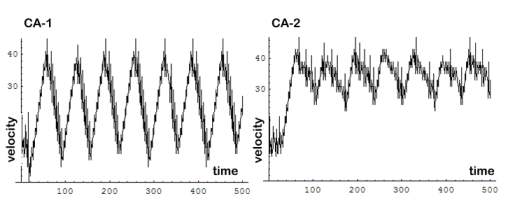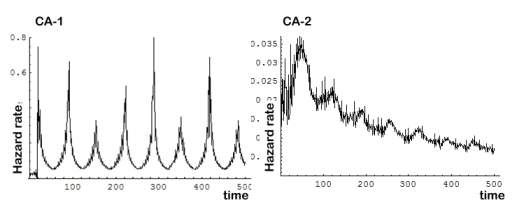 |
Hazard rate
The present experiment is continuation of the flip-flop experiment where the CA oscillated between two states, resource accumulation and output. Since it did not accumulate tolerance its health deteriorated. Health may be maintained by adding a tolerance accumulator to the system. The proliferon consists of a stem CA-0, CA-1 and CA-2. CA-2 accumulates tolerance which he gets from CA-1.
delivery[2, 1, k, 2] ;
delivery[2, 2, k, 2] ;
If[ p[1,prev] > p[1,now], set rule[250]]; Min[++k,
40], else [set rule[600]]
The CA starts as isolated processes (rule = 600).
At time = 20 the demand starts rising. When demand rises, CA-1 and
CA-2 switch between rules 600 and 250. When production{previous] >
production[now] the CA apply rule-600 and raise k, . When production{previous]
< production[now] the CA apply rule-250. At k = 40 they starts
declining. Since CA-2 gets tolerance from CA-1 it declines less.
 |
Hazard rate
Hazard rate is a good measure of the robustness of a CA. It is used by demographers to describe populations where it is known as force of mortality. Given a function f its hazard rate is f’ / f (derivative[f] / f ). Here f is tolerance, f’ is velocity, and hazard rate = v / tolerance.
The hazard rate of CA-1 oscillates. When CA-1 accumulates tolerance its hazard rate declines and during output it rises again. The hazard rate of CA-2 also oscillates, however since it accumulates tolerance the overall hazard declines.
 |
delivery:
[j, j-1, While[p[j-1] > set point], 2]
Argument[1]: Activated CA.
Argument[2]: Activating CA.
Argument[3]: Delivery condition.
Argument[4]: Delivery amount.
p[j]: daily production